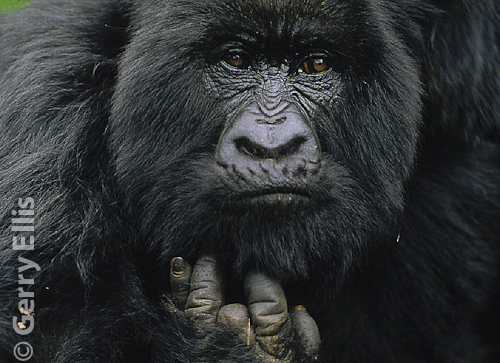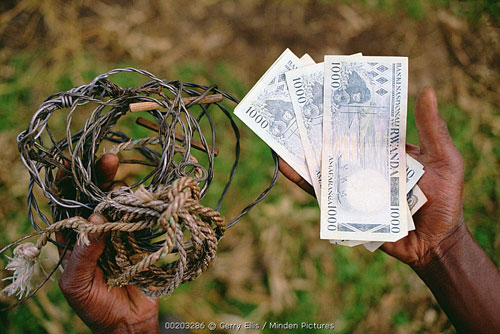Tags
bonobos, bushmeat, Democratic Republic of Congo, DRC, mountain gorillas, Pandora, poaching, Rwanda, snares, Virunga National Park

Pandora in 1994, her fingers amputated in poachers (bushmeat) snares booby-trapping the forests of Virunga Mountains.
Skye and I meet weekly, planning meetings to set the next couple years in motion. My research has changed one major element of those plans – more time and money looking at all things impacting apes – conservation issues.
As I type this post there are GPS units pulsing signals from the mountainous hillsides of Central Africa to satellites dangling high over the heart of the continent. With every signal sent and returned a cluster of digits indicates the location of mountain gorillas in the swath of mountainous greenery called the Albertine uplift – or the Virunga and Impenetrable Mountains. Folks from over a half-dozen NGO’s and several governments are conducting the single most comprehensive great ape, in this case mountain gorilla, census ever attempted. The world should be celebrating, this moment has taken decades to arrive at.
At the same time a whole set of 0’s and 1’s flow into my computer that causes me hesitation, to quell my celebratory emotions. As I dig through the research a cluster of facts surface that are, well frankly, portending an ominous next decade for mountain gorillas and all great apes. Rearing its ugly head in the research is poaching – bushmeat the most hideous, and wood for charcoal the most ominous.
Here’s just a few of the ugly facts:
- 1.1 million metric tons of bushmeat a year in Central/West Africa, including chimps, bonobos and lowland gorillas (= 4 million cattle.)
- $30 million in annual illegal charcoal production around the Virunga Mountains (DRC, Rwanda, Uganda.)
- DRC (Democratic Republic of Congo) is the only African nation with all four great apes – mountain and lowland gorillas, bonobos, and chimpanzees – it has been in some degree of war since 1998.
- The DRC war is the world’s deadliest conflict since World War II, killing 5.4 million people since 1998. The vast majority died from malaria, diarrhea, pneumonia and malnutrition.
- All bononos live in DRC – endangered, population unknown
- West Africa suffers from over 70% of Africa’s military coups.
- 55% of 200 million West Africans survive on $1 a day.
War and poverty ravage Central and West African nations. With guns a plenty from all those conflicts and hungry stomachs by the millions poaching is inevitable, and devastates these great ape range states. But faceless, nameless, poaching becomes a lost, another statistic, a casualty of war, it’s hard to relate.
Let me give it a face, a name.
*****
The above picture is of a grand old dame, Pandora. She died of natural causes, age 43, in the Virunga Mountains of Rwanda in June 2003. Pandora was a member of one of famed gorilla researcher Dian Fossey’s original study troops, Group 5, she was one of the first gorillas Dian Fossey observed when she founded the Karisoke Research Center. Ruling that troop with quiet confidence was the mountainous silverback, Ziz – the largest I ever saw. Ziz had a special connection to Pandora. In her later years another silverback, Shinda, a spirited blackback in Group 5 under Ziz, would also be drawn to Pandora.
I first met her when she was 31, in the prime of her life. It’s difficult to describe those days without the description having relational overtones. She was gentle, quiet, at time aloof. I was drawn to her physically and emotionally.

The irony of poaching snares and the bushmeat they kill paid for at one time with money illustrating the endangered mountain gorilla.
In Greek mythology Pandora was the first woman on Earth. Her name means “all-gifted.” Among all the attributes the Greek gods bestowed on her was curiosity. Our Pandora had lost digits to both curiosity and man’s inhumanity to all other living creatures. Like all apes, her curiosity was both a blessing and curse; big brains and opposable thumbs both inspire us to greatness and temp our demise. Pandora was the prodigy of both.
Over the course of her years Pandora’s curiosity lured her to tempt poachers bushmeat snares with her fingers. In those cruel split seconds the triggering peg snapped and the crude wire noose cinched, and Pandora’s finger or fingers were violently ripped from her hand. She was lucky, others lost whole hands or were desperately entwined until infection slowly robbed them of remaining life.
I worked for weeks to photograph Pandora’s hands, her absence of fingers. She hid them from me on most occasions, almost in embarrassment, as if their absence was and outward symbol of youthful stupidity; one of which she wasn’t proud.
Whenever I had a day with gorillas that wasn’t inspiring images I would hope to be with Group 5 and search out Pandora. I would sit near, just close enough to share in her gentleness, never so close as to disturb.
In her obit they said, “In her final years she was a favourite companion to the silverback Shinda, especially at grooming time. There is no doubt that Pandora’s chances of survival were dramatically improved because of the attention afforded by the Karisoke staff and the park rangers (all male) who monitor and protect the forest.” I was not alone, the staff and rangers were too smitten.
Poaching is killing. Bushmeat is death. Both reduce all creatures to mere meat. Neither tell of what lies in a soul.
Pandora is most infamously know for opening the box, a jar actually, and releasing its contents: evil. Evil that can’t be undone. Poaching is one of those. Yet, in thinking of our Pandora, and researching the plight of all us Hominids, I cling to the one content that didn’t escape: HOPE.
